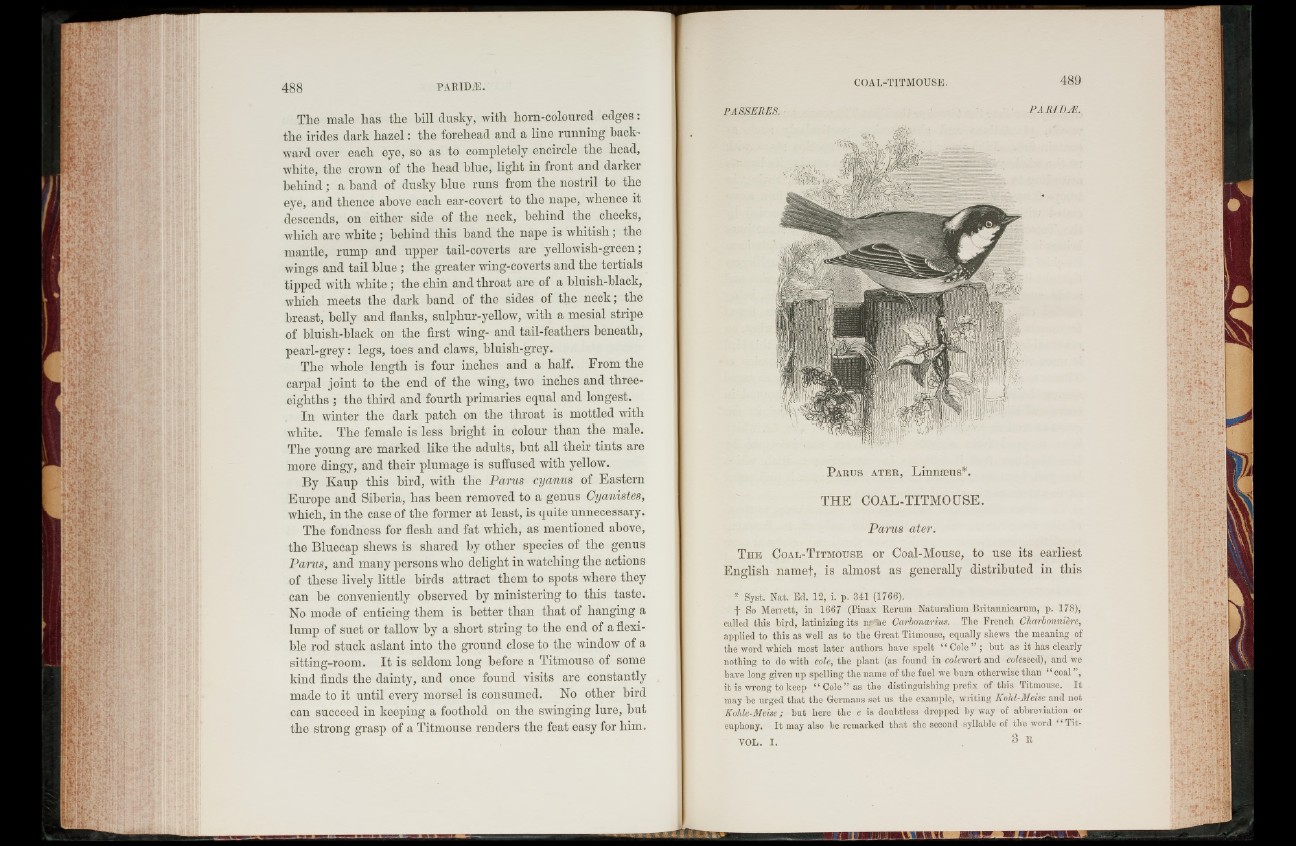
The male has the bill dusky, with horn-coloured edges:
the irides dark hazel: the forehead and a line running backward
over each eye, so as to completely encircle the head,
white, the crown of the head blue, light in front and darker
behind ; a hand of dusky blue runs from the nostril to the
eye, and thence above each ear-covert to the nape, whence it
descends, on either side of the neck, behind the cheeks,
which are white; behind this hand the nape is whitish; the
mantle, rump and upper tail-coverts are yellowish-green;
wings and tail blue ; the greater wing-coverts and the tertials
tipped with white ; the chin and throat are of a bluish-black,
which meets the dark hand of the sides of the neck; the
breast, belly and flanks, sulpliur-yellow, with a mesial stripe
of bluish-black on the first wing- and tail-feathers beneath,
pearl-grey: legs, toes and claws, bluish-grey.
The whole length is four inches and a half. From the
carpal joint to the end of the wing, two inches and three-
eightlis ; the third and fourth primaries equal and longest.
In winter the dark patch on the throat is mottled with
white. The female is less bright in colour than the male.
The young are marked like the adults, but all their tints are
more dingy, and their plumage is suflused with yellow.
By Kaup this bird, with the Parus cyanus of Eastern
Europe and Siberia, has been removed to a genus Cyanistes,
which, in the case of the former at least, is quite unnecessary.
The fondness for flesh and fat which, as mentioned above,
the Bluecap shews is shared by other species of the genus
Parus, and many persons who delight in watching the actions
of these lively little birds attract them to spots where they
can be conveniently observed by ministering to this taste.
No mode of enticing them is better than that of hanging a
lump of suet or tallow by a short string to the end of a flexible
rod stuck aslant into the ground close to the window of a
sitting-room. I t is seldom long before a Titmouse of some
kind finds the dainty, and once found visits are constantly
made to it until every morsel is consumed. No other bird
can succeed in keeping a foothold on the swinging lure, but
the strong grasp of a Titmouse renders the feat easy for him.
P A S S ERES. P A R IDÆ .
P a ru s a t e r , Linnæus*.
THE COAL-TITMO USE.
Parus ater.
T h e C o a l -T itm o u s e or Coal-Mouse, to use its earliest
English namet, is almost as generally distributed in this
* Syst. Nat. Ed. 12, i. p. 341 (1766).
f So Merrett, in 1667 (Pinax Reram Naturaliura Britannicarum, p. 178),
called this bird, latinizing its nr-'ne Carbonarius. The French Charbonnière,
applied to this as well as to the Great Titmouse, equally shews the meaning of
the word which most later authors have spelt “ Cole'’ ; hut as it has clearly
nothing to do with cole, the plant (as found in cole wort and coZcseed), and we
have long given up spelling the name of the fuel we burn otherwise than “ coal ”,
it is wrong to keep “ Cole” as the distinguishing prefix of this Titmouse. I t
may be urged that the Germans set us the example, writing Kohl-Meise and not
Kohle-Meise ; but here the e is doubtless dropped by way of abbreviation or
euphony. I t may also be remarked that the second syllable of the word “ Tit-
VOL. I . 8 R